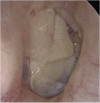Endoscopic Management of Pediatric Cholesteatoma
- PMID: 32110236
- PMCID: PMC7033597
- DOI: 10.1016/j.joto.2018.11.009
Endoscopic Management of Pediatric Cholesteatoma
Erratum in
-
Erratum regarding missing Declaration of Competing Interest statements in previously published articles.J Otol. 2020 Dec;15(4):179. doi: 10.1016/j.joto.2020.09.006. Epub 2020 Sep 26. J Otol. 2020. PMID: 33293923 Free PMC article.
Abstract
Pediatric cholesteatoma occurs in one of two forms: congenital cholesteatoma, developing from embryonic epidermal cell rests or acquired cholesteatoma, associated with a focal defect in the tympanic membrane. This disease has been traditionally managed with the operating microscope, often requiring mastoidectomy for adequate visualization of and access to the middle ear and mastoid cavities. Recently, advances in endoscopic equipment have enabled otologists to manage most cases of pediatric cholesteatoma via a minimally-invasive, transcanal endoscopic approach. This review discusses the current literature relating to the etiopathogenesis, assessment and endoscopic management of pediatric cholesteatoma. Early outcomes of endoscopic treatment, emerging trends and technologies are also reviewed.
Keywords: Cholesteatoma; Endoscopic; Mastoid; Middle ear; Minimally-invasive; Pediatric.
© 2018 PLA General Hospital Department of Otolaryngology Head and Neck Surgery. Production and hosting by Elsevier (Singapore) Pte Ltd.
Figures

















References
-
- Bacciu A., Di Lella F., Pasanisi E., Gambardella I., Saccardi M.S., Bacciu S., Vincenti V. Open vs closed type congenital cholesteatoma of the middle ear: two distinct entities or two aspects of the same phenomenon? Int. J. Pediatr. Otorhinolaryngol. 2014;78(12):2205–2209. - PubMed
-
- Clarke S.E., Mistry D., Al Thubaiti T., Khan M.N., Morris D., Bance M. Diffusion-weighted magnetic resonance imaging of cholesteatoma using PROPELLER at 1.5T: a single-centre retrospective study. Can. Assoc. Radiol. J. 2017;68(2):116. - PubMed
-
- Darrouzet V., Duclos J.Y., Portmann D., Bebear J.P. Congenital middle ear cholesteatomas in children: our experience in 34 cases. Otolaryngol. Head Neck Surg. 2002;126(1):34–40. - PubMed
-
- Djurhuus B.D., Skytthe A., Faber C.E., Christensen K. Cholesteatoma risk in 8,593 orofacial cleft cases and 6,989 siblings: a nationwide study. Laryngoscope. 2015;125(5):1225–1229. - PubMed
-
- Dornhoffer J.L. Hearing results with cartilage tympanoplasty. Laryngoscope. 1997;107(8):1094–1099. - PubMed
Publication types
LinkOut - more resources
Full Text Sources

